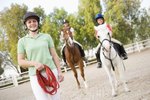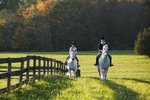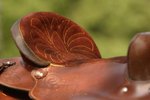
Control of the gallop -- the fastest and most dangerous gait a horse can achieve -- is essential for both safety and proper form. This four-beat gait increases duration of suspension, which is the amount of time that all four hooves leave the ground. The horse extends his nose and flattens his back, which makes him more difficult to control through rein and leg pressure. This is why it is important to practice control at slower gaits before progressing to the gallop.
Preparation
You the rider should master balance and control at the walk, trot and canter before attempting the gallop. Condition the leg muscles as well as the upper body to stay firm and flexible in the saddle, and develop endurance over extended periods at the trot and canter. Practice downward transitions so the horse understands when you expect him to slow down; for example, transition from the walk to the halt, then from the trot to the halt, and finally from the canter to the halt. The horse also requires the strength and cardiovascular health to sustain a gallop. Extended trot work helps build his endurance.
Location
A flat, contained area makes practicing easier. Fill in or level any holes or changes in elevations that could cause the horse to stumble. A controlled gallop requires even footing so the horse can maintain his balance. Large arenas work well for this purpose because you can ask for a gallop on the long sides of the arena, then transition back to a canter or trot on the short sides. If you gallop a horse in an open field, increase speed away from the barn, then transition down to a slower gait when approaching it. Barn sour horses often bolt toward their stalls if they are allowed to gallop in that direction.
Position
A two-point or half-seat position works best on a galloping horse. In two-point, you lift your seat out of the saddle entirely, which removes your weight from the horse's back. You bend slightly forward at the hip and sink your weight into her heels. A half-seat position provides more control and occurs when you shift some of your weight back into the saddle. Lift your head and chest, and shorten your reins to maintain constant contact between your hands and the bit.
Hand Gallop
A hand gallop works better at the start than a full gallop. During this extended canter, the horse lengthens his stride and flattens his back. It is more controlled than a full gallop and gives you more flexibility in terms of speed. In competition, such as eventing or jumper shows, the hand gallop is more common than the full gallop. If the horse attempts to reach greater speeds than you desire, collect him again or transition to a slower gait before trying again.
Safety
Warm up the horse with plenty of walking, trotting and cantering before attempting a controlled gallop. Make circles and serpentines to loosen his muscles and prepare his body. Since the gallop is harder on the horse's legs, he should wear bell boots as well as splint boots or sports medicine boots. This stops him from clipping his front coronet bands with his back hooves and protects his joints and ligaments from strain.
References
- HorseChannel.com: Gallop and Hand Gallop
- Riding: Ride with Confidence, Safety, and Good Form Right From the Start; Kate Delano-Condax Decker, page 137
- Horsemanship for Young Riders: Riding, Jumping, and Schooling; Jean Slaughter, pages 69-70
- The Seamless Seat: Creating the Ideal Connection With Your Horse; Kathleen Schmitt, pages 99-100
- EquiSearch.com: Beyond Two-Point: Full Seat, Half-Seat Positions
Photo Credits
-
BananaStock/BananaStock/Getty Images
Writer Bio
Laura College is a former riding instructor, horse trainer and veterinary assistant. She has worked as a writer since 2004, producing articles and sales copy for corporations and nonprofits. College has also published articles in numerous publications, including "On the Bit," "Practical Horseman" and "American Quarter Horse Journal."




